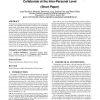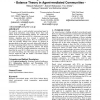283 search results - page 6 / 57 » Modelling socially intelligent virtual humans |
ATAL
2008
Springer
13 years 10 months ago
2008
Springer
Crowd simulation models are currently lacking a commonly accepted validation method. In this paper, we propose level of presence achieved by a human in a virtual environment (VE) ...
ATAL
2008
Springer
13 years 10 months ago
2008
Springer
We discuss the design of the Intermediary Agent's brain, the control module of an embodied conversational virtual peer in a simulation game aimed at providing learning experi...
IVA
2005
Springer
14 years 2 months ago
2005
Springer
An important characteristic of a virtual human is the ability to direct its perceptual attention to entities and areas in a virtual environment in a manner that appears believable ...
IAT
2007
IEEE
14 years 3 months ago
2007
IEEE
Existing models of virtual humans in urban settings have largely focused on algorithmic or graphical efficiency. They look realistic but are relatively lacking as experimental too...
ATAL
2003
Springer
14 years 1 months ago
2003
Springer
We sought to create a social embodied conversational agent to support group interactions, using ‘balance theory’ from social science research on human-human relations. We cond...




